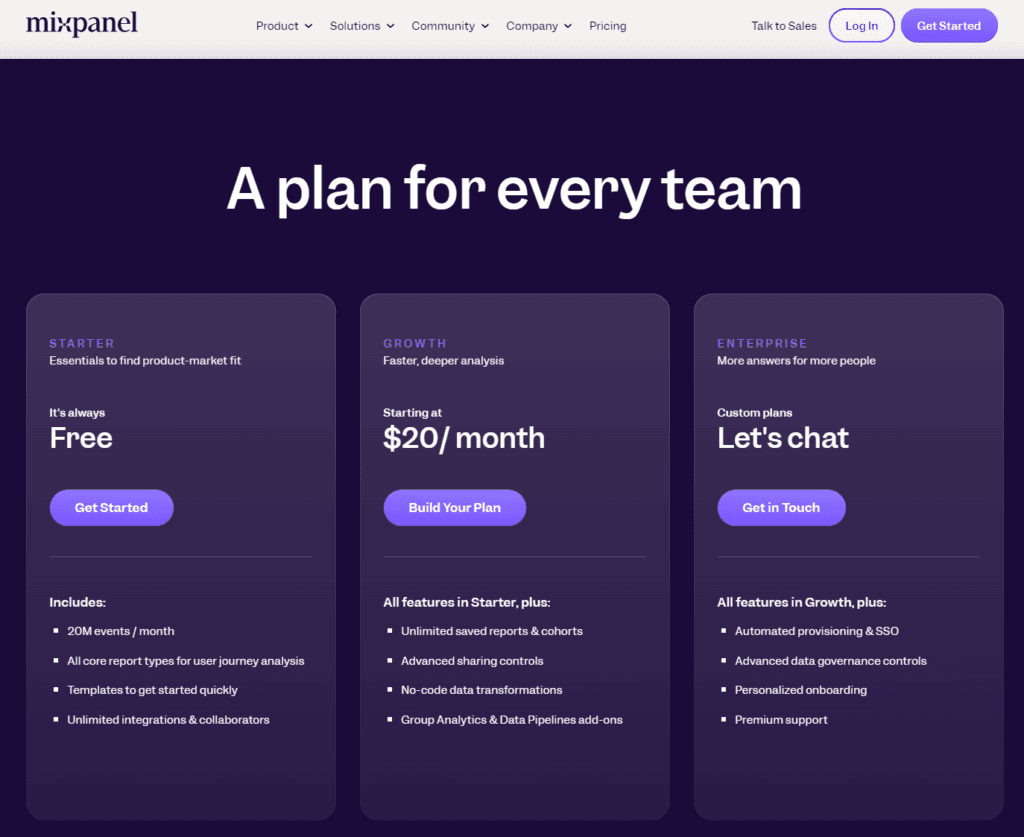Choosing between MicroStrategy and Mixpanel for your analytics needs is like deciding whether to buy a Swiss Army knife or a laser-focused scalpel. Both tools have their charm, their strengths, and their specific use cases. Whether you’re navigating the treacherous waters of enterprise-level analytics or looking to slice through user engagement data with surgical precision, making the right choice is crucial. But fear not! We’re here to dissect these tools, layer by layer, to help you find the perfect match for your business needs. Let’s start by comparing their approach to data analytics and user insights.
| MicroStrategy | Mixpanel |
|---|---|
 |  |
| G2 Score – 4.2 out of 5 stars | G2 Score – 4.6 out of 5 stars |
| TrustRadius Score – 8.4/10 | TrustRadius Score – 8.4/10 |
Data Analytics and User Insights
Peeling Back the Layers of Data
In the quest for the perfect analytics tool, the heart of the matter often lies in how effectively a platform can peel back the layers of your data to reveal the insights underneath. This is where the real magic happens, turning raw numbers into actionable intelligence that can drive your business forward. Both MicroStrategy and Mixpanel promise to uncover these layers, but they do so in markedly different ways, tailored to their respective audiences. Let’s delve deeper into their approaches to data analytics and user insights, exploring the nuances that might influence your choice.
MicroStrategy: The Strategic Visionary
MicroStrategy positions itself as the strategic visionary in the realm of data analytics, designed to serve large enterprises with complex data ecosystems. Imagine having the ability to survey the entire landscape of your business data from a high vantage point, where patterns and strategic insights become clear. This is the perspective MicroStrategy aims to provide. It’s not just about aggregating data; it’s about interpreting it in ways that align with your overarching business strategies.
The platform excels in drawing from a diverse array of data sources, offering a consolidated view that spans across departments. Whether it’s finance, operations, sales, or customer service, MicroStrategy brings together these different data streams into a cohesive narrative. Through detailed reports and dynamic dashboards, it translates complex datasets into visual stories that can inform high-level decision-making. The depth of analysis available is profound, enabling businesses to drill down into specifics while also keeping an eye on the broader strategic picture.
The challenge with MicroStrategy, however, is that its comprehensive capabilities come with a complexity that requires a certain level of expertise to navigate. Setting up and optimizing the platform to suit your specific needs can be a considerable undertaking, often necessitating a dedicated team of data professionals. But for organizations that can harness its full power, MicroStrategy offers unparalleled insights that can shape strategic direction and drive significant business growth.
Mixpanel: The User Behavior Expert
On the flip side, Mixpanel hones in on a specific, yet crucial, aspect of business data: user behavior and product interaction. It’s like having a microscope that allows you to zoom in on how users engage with your digital products, from the features they use most to the points where they disengage. This focused approach is invaluable for businesses looking to refine their product offerings or enhance user experience based on real, actionable data.
Mixpanel’s strength lies in its ability to track individual user actions, rather than just page views or broad metrics. This granularity unlocks deep insights into the user journey, enabling businesses to identify trends, behaviors, and opportunities for optimization. For product managers, marketers, and UX designers, this level of detail is gold, offering direct feedback on what’s working, what isn’t, and how users are truly interacting with their digital offerings.
Moreover, Mixpanel’s interface and setup are designed with accessibility in mind, ensuring that teams can quickly derive value from the data without needing deep technical expertise. The platform emphasizes immediate, actionable insights that can directly influence product development and marketing strategies, making it a powerful tool for businesses focused on agile, data-driven iteration.

Related: Check out our free SEO suite

Integration and Compatibility
The Lifelines of Your Analytics Ecosystem
In the vast landscape of business tools and software, your analytics platform isn’t just another application—it’s the central nervous system that interprets and understands the vast amounts of data your business generates. But for it to function optimally, it needs to be well-integrated and compatible with the other systems in your digital ecosystem. This seamless integration ensures that data flows freely and accurately between systems, enabling you to make informed decisions based on comprehensive insights. Let’s delve deeper into how MicroStrategy and Mixpanel fare in this crucial aspect, considering their roles in harmonizing your business’s data symphony.
MicroStrategy: The Master Orchestrator
MicroStrategy takes on the role of a master orchestrator in the world of business analytics, boasting an extensive repertoire of integration capabilities designed to harmonize a wide array of data sources and applications. This platform understands the importance of a unified analytics environment, especially for large enterprises that rely on diverse data systems spanning across various departments and functions. With its sophisticated architecture, MicroStrategy allows businesses to connect with everything from traditional relational databases and big data solutions to cloud services and real-time data streams. This extensive connectivity ensures that organizations can pull in data from multiple sources, offering a 360-degree view of operations and strategic insights.
But MicroStrategy’s prowess doesn’t stop at data integration. It also shines in its ability to embed analytics into other business applications, offering APIs and SDKs that enable the creation of custom analytics applications and the integration of insightful dashboards directly into existing business software. This level of integration capability not only enhances the accessibility of analytics across the organization but also ensures that decision-makers have direct access to actionable insights within the applications they use daily. The challenge, however, lies in navigating the complexity of setting up and maintaining these integrations, often requiring a dedicated IT team to leverage the full scope of MicroStrategy’s capabilities effectively.
Mixpanel: The Agile Connector
In contrast, Mixpanel approaches integration with a focus on agility and user-centric insights, positioning itself as the agile connector within the digital product space. It excels in forging strong connections with tools that digital businesses rely on, from CRM and email marketing platforms to A/B testing and customer support tools. This targeted approach ensures that insights into user behavior and product performance are not siloed within the analytics platform but are instead actively informing and enhancing other aspects of the business. For example, understanding user interactions and feedback loops can directly influence email marketing campaigns or product development priorities, creating a cohesive strategy driven by data.
Mixpanel’s integration strengths lie in its simplicity and the immediate value it provides to product teams and marketers. Setting up connections between Mixpanel and other tools is designed to be straightforward, often requiring minimal technical expertise. This ease of integration makes Mixpanel particularly appealing to startups and fast-growing companies that value speed and flexibility. They can quickly adapt their toolset as their product evolves, ensuring that their analytics capabilities keep pace with their growth without being bogged down by complex integration projects.
Scalability and Growth Support
Scaling New Heights with the Right Tool
As your business grows, so do your data and analytics needs. It’s like climbing a mountain; what worked at the base might not work at the summit. That’s why considering how well an analytics tool can scale with your business is crucial. Let’s scale the scalability mountain with MicroStrategy and Mixpanel and see which one can keep you roped in for the long haul.
MicroStrategy: Built for the Enterprise Summit
MicroStrategy is like an experienced mountain guide for scaling the enterprise summit. It’s built with large corporations in mind, those that generate vast amounts of data across multiple departments and require comprehensive insights to drive decisions at every level. This platform doesn’t just scale; it thrives on complexity and volume, designed to handle the increasing data loads of growing enterprises without breaking a sweat.
The architecture behind MicroStrategy ensures that as your business expands, adding more data sources, users, or complex analytics needs, the platform can accommodate these changes efficiently. This scalability is a core feature, allowing for the addition of new capabilities, from advanced AI analytics to mobile reporting, without disrupting existing operations. It’s the kind of tool that grows with you, ensuring that no matter how complex your data environment becomes, you have the analytics power to match it.
Mixpanel: Agile Scaling for Product and User Insights
Mixpanel, on the other hand, is like the lightweight, agile climbing gear for businesses focused on digital products and user experiences. It’s perfectly suited for startups and mid-sized companies that prioritize understanding and improving user engagement over broad enterprise analytics. Mixpanel scales by deepening the insights into user behavior, offering more granular data as your user base grows.
This focus on product and user analytics means that Mixpanel is inherently scalable within its domain. As your product evolves and your user base grows, Mixpanel provides the insights necessary to fuel this growth, from pinpointing why users churn to identifying what features drive engagement. The platform’s scalability lies in its ability to provide increasingly sophisticated insights without requiring significant increases in configuration or management, making it ideal for fast-paced, growth-oriented companies.
Cost and Pricing Structures
Investing Wisely in Your Analytics Journey
The cost of an analytics tool isn’t just about the price tag attached to it; it’s about the value it brings to your business in exchange for that investment. Like any good investment, the goal is to put your resources into something that grows in value, providing insights and efficiencies worth more than the initial outlay. Let’s navigate the cost and pricing structures of MicroStrategy and Mixpanel to see which tool offers the best return on investment for your specific needs.
MicroStrategy: The Enterprise Investment

MicroStrategy positions itself as a high-end investment, with pricing that reflects its comprehensive suite of features and enterprise-level capabilities. Think of it as investing in a luxury car; it’s not just about getting from point A to point B, it’s about how you get there. With MicroStrategy, the investment is in a platform that offers depth, scalability, and a wide array of advanced analytics features designed to serve large corporations with complex data landscapes.
The pricing model for MicroStrategy is tailored to these large-scale implementations, often involving customized quotes that take into account the scope of deployment, the number of users, and the specific features required. This bespoke pricing ensures that businesses pay for what they need, but it also means that the cost can be significant, especially for smaller businesses or startups just dipping their toes into advanced analytics.
Mixpanel: The Flexible and Scalable Option

Mixpanel offers a more flexible and straightforward approach to pricing, making it accessible for businesses of all sizes. It’s akin to choosing a car with great mileage; it gets you where you need to go efficiently, without the luxury price tag. Mixpanel’s pricing structure is designed to scale with your usage, particularly focusing on the number of events tracked, which makes it especially attractive for digital-first businesses that need to deeply understand user behavior without committing to a hefty initial investment.
With free tiers and scalable pricing plans, Mixpanel allows startups and small to medium-sized businesses to start small and grow their investment as their needs evolve. This pay-as-you-grow model ensures that companies can access powerful analytics capabilities without a large upfront cost, aligning their expenditure with business growth and the increasing value derived from the insights Mixpanel provides.
Conclusion
MicroStrategy stands as a beacon for enterprises seeking a comprehensive analytics solution that can capture and interpret the complexities of their data ecosystem. It’s the choice for those who need a panoramic view of their operations, with the capability to dive deep into the strategic nuances of their business. This platform offers a robust foundation for data-driven decision-making, designed to scale with the complexities and growth of large organizations.
On the other hand, Mixpanel offers a laser-focused approach to understanding user behavior and product interaction, making it the ideal companion for businesses dedicated to optimizing their digital offerings. With its user-centric analytics and straightforward integration capabilities, Mixpanel empowers teams to iterate rapidly and effectively, ensuring that every product decision is informed by data.
Read Next:





















